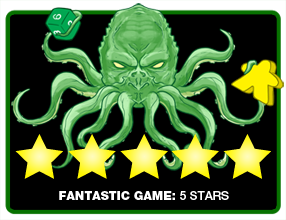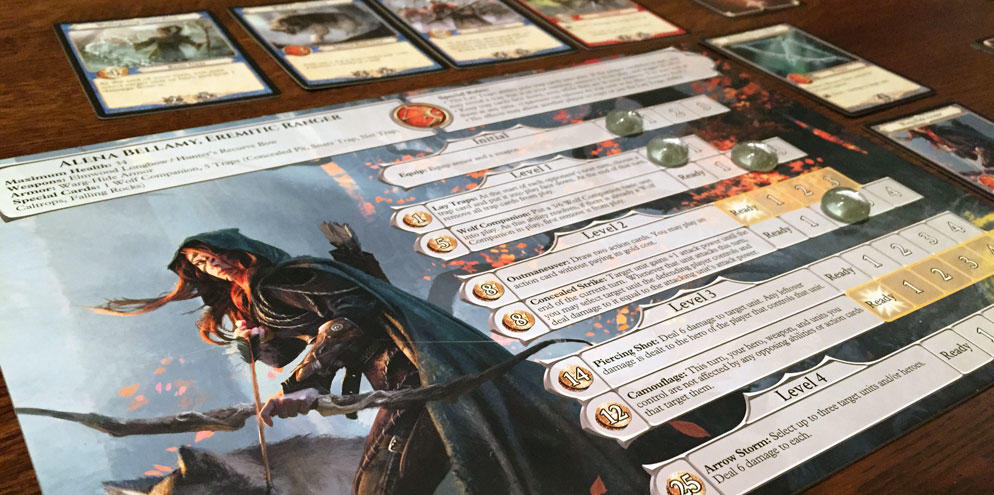 In the genre for dueling card games, gamers are blessed with an abundance of choices. From the granddaddy that is Magic: The Gathering, to asymmetrical games like Android: Netrunner, to hybrid games like Ashes: Rise of the Phoenix Born, there is something for just about everyone.
In the genre for dueling card games, gamers are blessed with an abundance of choices. From the granddaddy that is Magic: The Gathering, to asymmetrical games like Android: Netrunner, to hybrid games like Ashes: Rise of the Phoenix Born, there is something for just about everyone.
Allegiance: A Realm Divided successfully funding on Kickstarter in 2014 to over 1,000 eager backers. In Allegiance, each player controls a powerful hero who will lead an army of units in battle against their opponents. Allegiance will suck you in with its utterly fantastic visuals, but the question remains if the gameplay can hold its own in this crowded genre. Time to find out!
Allegiance: A Realm Divided is a dueling card game for 2-4 players that takes about 45 minutes to play.
Game Overview:
In Allegiance, each player takes control of one of ten different heroes. Each hero has seven unique powers, a weapon and suit of armor (usually), and possibly some special abilities and cards.
During the game, players will be drawing cards from 3 shared decks (Basic Unit, Elite Unit, and Action) and using those to summon troops to battle. Each unit will has its own attack power, health, and possibly some special abilities. Players will be using a combination of hero powers, action cards, and units to attack their opponents. The goal in Allegiance is to reduce your opponent’s health to zero.
Game Components:

Allegiance: A Realm Divided is the first game published by Underground Games and I must say I was beyond impressed with the production quality of Allegiance. They really put together an amazing looking product here.
First, the visuals and artwork for the heroes are some of the best I’ve seen in a game. They’re absolutely stunning. The game comes with 10 different heroes printed on a large boards made of a nice thick stock. Each hero feels really unique and will approach the game a little differently.
For cards, players share the three decks mentioned above. There is also an equipment deck and a deck of special cards. Cards from these are distributed to players depending on the heroes chosen. All cards are printed with original art on high quality stock. The game also comes with dividers and foam inserts to keep everything organized.
The game also comes with a pile of red and blue dice to be used as health and augment counter (respectively). Also included are glass beads to track power cool downs, hero health, and gold production.
Finally, the game comes with a hero booklet, an art and lore book, and a very thorough rulebook. The rulebook goes into great detail on every aspect of the game and I had no trouble learning the game from it. We also had minimal issues referencing it during gameplay and were able to answer any rule questions that came up. It’s nice to see a rulebook done well enough that I don’t have to jump online to find answers.
How to Play:
Each player starts the game with a hero board (along with any hero specific cards), a resource board, and 4 cards (1 action, 2 basic units, 1 elite unit).

In Allegiance, each player rotates taking turns, with each turn having five phases:
1. Production Phase: Increase your production rating (starts at 5) by 1. Then gain an amount of gold equal to your production rating.
2. Refresh Phase: Move all of your hero’s cooldown counters one space towards ready. Refresh any exhausted cards in your territory.
3. Draw Phase: Draw a card from the deck of your choice.
4. Maneuver Phase: You may play any number maneuvers, in any order. Options include:
- Unlock a Hero Ability: Pay the gold cost of a hero ability to unlock it.
- Use a Hero Ability: Use one of your unlocked hero abilities.
- Enlist a Unit: Play a unit card from your hand into your territory by paying the gold cost. Units cannot attack the turn they enter play.
- Play an Action Card: Play an action card from your hand by paying the gold cost.
- Initiate a Battle: When you start a battle, you choose any number of your units to attack the opposing hero. You may also attack with your hero’s weapon, if they have one. Your opponent may choose to block any of your units with their unexhausted units. Unblocked units do their damage to the opposing hero. Blocked units do damage to each other. Units are exhausted after attacking.
5. End of Turn Phase: A final chance for players to play maneuvers. End of turn events can also trigger here.
After a player finishes their turn, the next player takes theirs. This process is repeated until there is only one player left alive.

Game Experience:
I had a chance to play a prototype version of Allegiance before its Kickstarter campaign and found it quite enjoyable. Now that I’ve got the final copy of the game in my hands, I must say, I love it. Underground Games did an amazing job with this one.
While I don’t want to dwell on it for very long, I do need to address the elephant in the room. That’s the similarities to Magic: The Gathering. Allegiance does share some Mechanics with Magic, notably the way units handle combat. But really, that’s about where the similarities end. Granted that’s a decent part of the game, but it didn’t diminish my enjoyment in the slightest. In fact, I actually prefer Allegiance to Magic by a WIDE margin. But suffice to say, if you are a fan of Magic, then you should really enjoy Allegiance.

Moving on, let’s talk about the heroes. It’s easily my favorite part of the game. Putting aside the fantastic artwork, I love the uniqueness of each hero. Some can get a crazy amount of units on the battlefield; there is another that’s really good at exhausting opposing units, and others that are good at stealing units. There is so much variety here that it gives the games a lot of replay value. I love games like this because it makes me want to try out each and every hero, which translates to Allegiance getting to the table quite often.
In contrast to the heroes, almost all cards are drawn from a shared deck. While I have enjoyed deck building in these types of games in the past, I rarely have time to do that anymore. So it’s nice that we can jump in and start playing without worrying about building a deck first (and then worrying if it’s even any good). At first, I wasn’t sure if I’d like the idea of shared decks, but I thought it ended up being a great choice. It makes the entire game of Allegiance to be fully self-contained. I can bring a copy to the table and no matter whom I’m playing with; we can jump in and be on even footing.

For the game play, there are a lot of choices to be made in Allegiance. From which of the shared decks to draw your card from, to which powers to unlock first, or even how to spend your gold, Allegiance gives you a lot to do. I do like how gold is the only resource in the game, and it’s provided at a steady build. This gives the game a nice ramp-up that’s slow at the start, but powerful at the end. It also removes some of the luck in the game as it prevents players from being hampered by not having a resource they need. Everyone is on equal footing when it comes to spending.
I’m grateful that Allegiance isn’t a CCG (or even an LCG). Everything you need to play is right there in the box. I’m sure there will be an expansion at some point, but it’s nice to know that I can have a ton of variety and replay value without having to spend truckloads of money on booster packs.
Finally, while I do think Allegiance plays best with two players, they did come up with some clever solutions for multiplayer. There is the standard free for all, which I usually avoid because it inevitably causes someone to be ganged up on. Instead, I’d opt for the sworn enemy mode (if I didn’t want to do a team game). In this mode, you only need to attack the player to your left. This creates a nice balance and insure that every has a fair shake.

Final Thoughts:
I must say, I’m thoroughly impressed with the quality of Underground Games first offering. From the absolutely fantastic production values, to its highly engaging game play, Allegiance: A Realm Divided has set the benchmark for what a Kickstarter game should be. Other first time publishers take note; this is how you do it.

I honestly don’t have a lot of complaints for Allegiance: A Realm Divided. The heroes are all interesting to play, feel different from each other, and I am dying to try each one to see who I enjoy the most. The mechanics, while not wholly unique, do provide a nice take on the familiar card dueling genre. I enjoyed every play of Allegiance and it has quickly replaced just about every other dueling card game in my collection. If I want to battle someone with cards, I’m grabbing Allegiance.
If you ever wanted to dip your toes into this genre and were scared of the money sink that is Magic, then Allegiance is absolutely worth checking out. It’s an amazing game that has me itching to get it to the table again soon.
If you’d like to get a copy of Allegiance: A Realm Divided for yourself, you can pick it up for about $65.
Final Score: 5 Stars – Exactly what I want in a dueling card game. The mechanics are intuitive, gameplay fun, and artwork amazing.
 Hits:
Hits:
• Easy to learn rules
• Unique heroes
• Balanced game play
• High replay value
• Awesome production values
Misses:
• Those who didn’t kick the game are missing out on two promo heroes.























Interesting review. I like the fact that you mentioned there’s a signle shared deck.